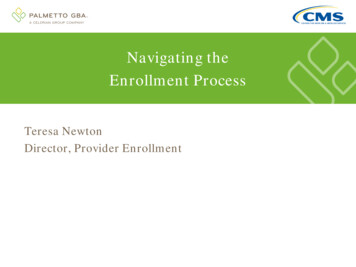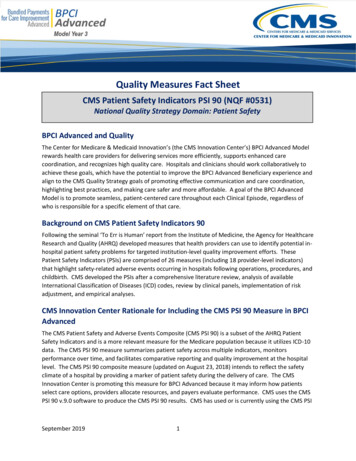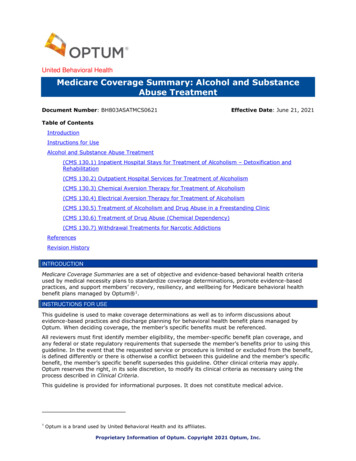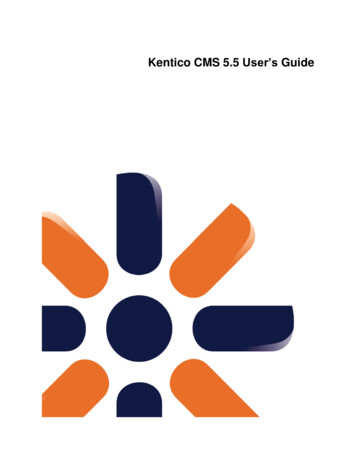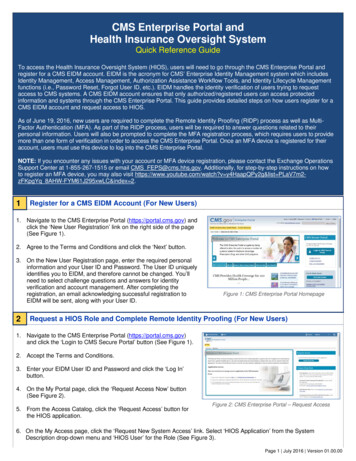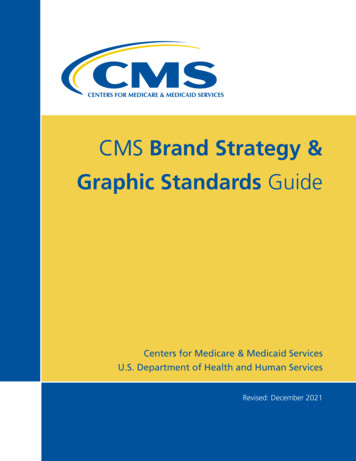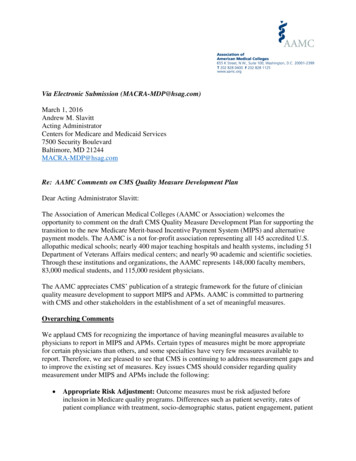
Transcription
Via Electronic Submission (MACRA-MDP@hsag.com)March 1, 2016Andrew M. SlavittActing AdministratorCenters for Medicare and Medicaid Services7500 Security BoulevardBaltimore, MD 21244MACRA-MDP@hsag.comRe: AAMC Comments on CMS Quality Measure Development PlanDear Acting Administrator Slavitt:The Association of American Medical Colleges (AAMC or Association) welcomes theopportunity to comment on the draft CMS Quality Measure Development Plan for supporting thetransition to the new Medicare Merit-based Incentive Payment System (MIPS) and alternativepayment models. The AAMC is a not for-profit association representing all 145 accredited U.S.allopathic medical schools; nearly 400 major teaching hospitals and health systems, including 51Department of Veterans Affairs medical centers; and nearly 90 academic and scientific societies.Through these institutions and organizations, the AAMC represents 148,000 faculty members,83,000 medical students, and 115,000 resident physicians.The AAMC appreciates CMS’ publication of a strategic framework for the future of clinicianquality measure development to support MIPS and APMs. AAMC is committed to partneringwith CMS and other stakeholders in the establishment of a set of meaningful measures.Overarching CommentsWe applaud CMS for recognizing the importance of having meaningful measures available tophysicians to report in MIPS and APMs. Certain types of measures might be more appropriatefor certain physicians than others, and some specialties have very few measures available toreport. Therefore, we are pleased to see that CMS is continuing to address measurement gaps andto improve the existing set of measures. Key issues CMS should consider regarding qualitymeasurement under MIPS and APMs include the following: Appropriate Risk Adjustment: Outcome measures must be risk adjusted beforeinclusion in Medicare quality programs. Differences such as patient severity, rates ofpatient compliance with treatment, socio-demographic status, patient engagement, patient
preferences for treatment approaches, and sites of care, can all drive differences inoutcomes. The issue of addressing sociodemographic factors is critical, particularly whenmeasuring outcomes among certain populations. Appropriate risk adjustment is essentialso that differences in patient characteristics that are beyond a health care provider’scontrol do not have an unfair impact on a provider’s performance score either underMIPS or any other program. The AAMC requests that CMS support additional researchefforts to examine and account for appropriate risk adjustment moving forward. Holistic and Continuous Review of Measures: CMS should review measures in theMedicare programs holistically in order to ensure that new measures add value, are usefulfor consumers, and promote alignment across programs. The Agency should develop aprocess to routinely identify and remove those quality measures that are either topped-outor no longer adhere to clinical guidelines. Follow a Transparent Process: Measures should be developed through a transparentprocess that engages stakeholders in the development. There should be a process in placefor removal of measures that are “topped out”, no longer comply with clinical guidelines,or are duplicative. Sufficient Time for Implementation: CMS should ensure that physicians have time toadapt to new measures. As additional measures are incorporated into the MIPSperformance programs, CMS should ensure that individuals and group practices havesufficient time -- a minimum of 18 months -- to implement the necessary infrastructure tocapture and test such information before a measure is required under the performancecategories. Reduce Administrative Burden: As physicians transition to the MIPS program andalternative payment models, CMS should take steps to limit administrative burdenassociated with reporting quality measures under these programs. Reducing burden inmeasurement reporting and documentation requirements will enable physicians to focuson high quality patient care.Multi-Payer Applicability Measures (page 23)MACRA requires CMS to consider how measures used by private payers and integrated deliverysystems should be incorporated in Medicare quality programs. Quality measures currently in useby public and private payers include multiple measures for the same measure topic, resulting induplication. CMS plans to leverage multi-stakeholder groups, such as Measures ApplicationPartnership (MAP), the Core Quality Measures Collaborative, and the Health Care PaymentLearning and Action Network (HCPLAN) to identify creative solutions.The AAMC supports the continued use of the MAP to advise on prioritization of measures forthe MIPS program and to help identify critical gaps in measures. MAP obtains input from thepublic as part of the MAP review process, which helps to identify the most appropriate measures.However, we recommend that CMS and MAP establish a longer time frame for public reviewand comment on measures under consideration. We also support CMS continued participation inthe Core Quality Measures Collaborative and the Health Care Payment Learning and Action2
Network. We recommend that CMS share and ensure consistency in the strategies of thesegroups related to the quality measures, attribution, risk-adjustment methodology, and otherrecommendations.Quality Domains and Priorities (page 30)MACRA identifies five quality domains (i.e., clinical care, safety, care coordination, patient andcaregiver experience, population health and prevention) for measures developed under the MDP.CMS states that it will collaborate with specialty groups and associations to develop measuresthat are important to patients and providers and that represent important performance gaps. CMSindicates that it will prioritize outcomes, person and caregiver experience, communication andcare coordination and appropriate use/resource use.As recommended by the IOM in its April 2015 Vital Signs report, the AAMC supports theinclusion of core measure sets to help reduce provider reporting burden. Core measures are highimpact metrics that would be required to be reported by all physicians. Core measures sets areintended to help level the playing field by discouraging physicians from exclusively reportinglow-value measures. That being said, the AAMC does not believe that the National QualityStrategy (NQS) domains are the right approach for developing a core measure set. Too often, theNQS domains lack a sufficient number of relevant measures for physicians, making achievementof these domains impossible. The AAMC asks CMS to engage stakeholders to determineappropriate core measure sets for the MIPS program.CMS should focus on a limited number of process and outcomes measures that are broad enoughto ensure participation among a range of specialties. To accomplish this goal, the Associationrecommends that CMS work with stakeholders to perform a holistic review of the currentmeasures in the PQRS, VM, and Meaningful Use (MU) programs. The Agency should selectthose measures for the MIPS that are high-impact due to either significant variation inperformance among physicians or because the measures fill a recognized quality gap.Clinical Care (page 31)The clinical care domain consists of measures that reflect clinical care processes closely linked tooutcomes or measures of patient centered outcomes. CMS states in the plan that outcomemeasures and adherence to clinical practice guidelines are measurement development prioritiesfor MIPS and APMs.AAMC supports the development of valid and reliable outcome measures that could potentiallylead to more direct measures of quality and encourages their development. We recommend thatCMS acknowledge that outcome measures at the physician level can be particularly challengingwhen used in quality programs due to small sample sizes, risk adjustment, attribution, and theimpact of factors outside of the physician’s control.The issue of addressing sociodemographic factors, particularly when measuring outcomes iscritical. Recent studies have clearly demonstrated that SDS variables (such as income andeducation) are risk factors for adverse outcomes. Physician practices that care for vulnerable3
patient populations are disproportionately disadvantaged when SDS factors are not accounted forin outcome measurement. Many of the patients cared for by AMCs are poorer, sicker and morecomplex and therefore typically require higher resource utilization. In order to reasonablycompare physicians who treat a range of patients with different case mixes, outcome measuresmust be adjusted for both clinical and SDS factors, and should incorporate beneficiary riskscore. The AAMC believes that there are ways to appropriately adjust for SDS by incorporatingSDS factors in the risk adjustment methodology. The AAMC also believes that outcomemeasures should be adjusted for patients who do not comply with clinician guidance.Care Coordination (page 32)In the draft MDP CMS discusses the inclusion of care coordination in the MIPS performancecategory of clinical practice improvement activities. To promote improved care collaboration,CMS highlights the need for primary and specialty accountability across care settings. Care forpatients, particularly those with multiple chronic illnesses, is done by providers across manyspecialties. The AAMC strongly supports a system that avoids redundant care, conflictingmanagement advice, high costs and inconvenience.An example of a model that promotes care coordination can be found in the AAMC’s work with5 academic medical centers. Working under a CMMI Health Care Innovation Award’s grant, theAMC’s are implementing a new model of care delivery and technology to allow primary careproviders to receive timely, electronic consultations from specialist colleagues. The primary carephysician and the specialist receive reimbursement for the time they spend on the consultprovided that the consult does not become a referral for a specialty visit. These e-consultsenhance care coordination between providers, thereby creating sustainable reductions inunnecessary care. When appropriately implemented, we believe this will reduce costs,utilization, increase patient satisfaction, and improve quality.AAMC recommends that CMS recognize in the draft plan the importance of developingmeasures of team-based care. Given the complexity of patient care, it is common for multipleclinicians to provide care to the same patient as part of a team with the goal of the best possiblecare. Each clinician relies upon information and action from other members of the team. A highperforming team is an essential tool for a patient centered, coordinated and effective health caredelivery system. In the future, it will be important to measure how a team performs on healthcare quality, costs, and health outcomes.Population Health and Prevention (page 34)MIPS allows for the use of “global and population based measures” in the quality performancecategory. CMS states in the report that it will consider developing or adapting outcome measuresat a population level to assess the effectiveness of health promotion and preventive services.CMS references the Measure for Adult Smoking Prevalence (NQF #2020).AAMC has concerns with applying measures that were designed for use at the “population” levelto clinicians. Population based measures are typically designed to allow communities to evaluatetheir systems at a macro level and so have not been tested for use at the clinician level. For4
example, CMS is currently using two population based measures, PQI 91 and 92, in thephysician value based modifier program. These measures were originally designed to measureambulatory sensitive conditions based on a large sample size (100,000) at the community level.Applying these specific measures that are intended to address overall admission rates at apopulation level to individual physicians in the Value-based modifier program has penalizedphysicians who treat patients with multiple chronic conditions. The bias against providers whocare for complex patients is clearly demonstrated in the 2015 Value Modifier Experience Report.This report showed that of the 106 groups that went through quality tiering, none of the groupswith the patients in the highest quartile of risk received an upward adjustment, and a little over30 percent had a downward adjustment. Therefore, we have significant concerns with the use ofPQI 91 and 92 and other similar population based measures in the MIPS program. The MAPClinician Workgroup reviewed PQI 91 and 92 at its meeting in November 2015 and expressedsimilar concerns with the application of these population based measures to individual clinicians.Therefore, the AAMC requests that PQI 91 and 92 be removed from all physician performanceprograms, and that CMS avoid the future inclusion of population based metrics in the MIPSprogram and APMs until these issues have been resolved.Efficiency and Cost Reduction Measures (page 34)In addition, to the five quality domains identified in MACRA, CMS proposes to includeefficiency and cost reduction as a quality domain. This domain consists of quality measures thatreflect efforts to lower costs, reduce errors, and significantly improve outcomes. CMS indicatesin the plan that measures of appropriate use of services, including measures of overuse, are avery high priority for measure development for MIPS and APMS. CMS indicates that it willensure that measure developers consider evidence-based practices related to overuse andreferences the Choosing Wisely Initiative.The AAMC supports the use by physicians of evidence-based clinical support systems to guidetheir treatment for particular patients. The Choosing Wisely Campaign’s purpose is to promoteconversations between patients and their providers around potentially unnecessary tests,treatments, and procedures. The Choosing Wisely guidelines are not intended to be absolute. Werecommend that any measures of overuse based on “Choosing Wisely” guidelines beimplemented after the specialty that provides the service have chosen to use the guidelines tocreate applicable measures that are based on solid evidence, and developed through a processthat is inclusive of all specialties that provide the service in question. In the interim, physicianswho follow the Choosing Wisely guidelines should be given credit in MIPS under the ClinicalPractice Improvement Category.As providers focus on performance on overuse measures, a potential unintended consequence ofquality measurement is underuse of services. As measures are developed for other qualitydomains, CMS should also consider the development of “balancing measures” that can mitigatethe potential for unintended consequences.Furthermore, CMS should be careful to avoid quality measures that would hinder the use of morecostly procedures without considering the beneficial outcomes of these procedures. Some5
procedures may have higher upfront costs, but have better outcomes and result in lower costs inthe long-term.Quality Measures Use In APMsThe AAMC recommends that in the Draft plan CMS address the approach to quality measuresthat would be used for eligible alternative payment models. MACRA requires the MDP requiresquality measures used in APMs to be comparable to the quality measures used in MIPS. TheAAMC urges CMS to allow for maximum flexibility in how quality is measured for APMs.“Comparable” does not mean “the same” and should not be defined that way. APMs are newerand more innovative models of care. It is important that APM quality measures are consistentwith this new way of delivering care. Quality in an APM may involve reductions in cost,increases in efficiency, and improved outcomes. Additionally, measures used to assess quality inan APM should ideally be reviewed by stakeholders, tested, and continuously evaluated toensure that the quality metrics are meaningful to both the patients and providers. Finally, asnoted by the AMA, quality measure reporting for an APM should be no more burdensome thanunder MIPS. There should be a focus on harmonizing measures so that there is consistency inhow care is measured among MIPS and, APMs, and Medicare and other payers.CMS Should Ensure that Publicly Reported Data is Valid, Reliable, Accurate, andMeaningfulIn the Draft plan, CMS discusses the MACRA requirement that performance and participationinformation under MIPS and APMs be made available for pubic reporting on the PhysicianCompare website. CMS intends to continue public reporting of performance results through thePhysician Compare website based on measures in the MIPS program through either the clinicianweb page or through a downloadable spreadsheet. We recommend that CMS include a morerobust discussion in the draft document regarding plans for public reporting of physicianperformance on quality measures under MIPS.The AAMC recommends that in the initial years of the MIPS program, CMS include dataindicating whether an eligible professional (EP) satisfied the reporting requirements for thequality measure. However, calculating and displaying performance data on the public website inthe early years of the program would be premature. At this early stage there are too manychallenges with measures related to risk adjustment, attribution, sociodemogaphic factors topublicly report performance data CMS should only report measures that are valid, reliable, andaccurate, and are meaningful to consumers and providers. Physicians should have theopportunity to review data for accuracy and request that errors be corrected prior to publicreporting.Consideration for Electronic Specifications (page 38)In the draft plan, CMS discusses the challenges facing electronic clinical quality measure(eCQM) selection for MIPS and APMS. The AAMC requests that’s the quality developmentplace reflect the considerable burden that new eCQMs place on providers. Physician practiceEHRs need to be frequently reconfigured to meet the needs of the MIPS and APM reporting6
requirements. Therefore, the Association asks that the draft plan reflect concerns that neweCQMS should not be added or removed more than once per year, and should give providersmultiple years of notice regarding changes to the e-CQM requirements. Physicians needsubstantial time to understand and implement new e-CQMS before they are publicly reported.The AAMC asks that CMS work with other governmental agencies to standardize protocolsacross electronic medical systems in order to help reduce provider burden.Thank you for consideration of these comments. The AAMC looks forward to continuing tocollaborate with CMS in the future as you work to identify measurement and performance gaps,and develop quality measures for use in MIPS and APMs. If you need additional information,please contact Gayle Lee (galee@aamc.org, 202-741-6429) or Scott Wetzel (swetzel@aamc.org,202-828-0495).Sincerely,Janis M. Orlowski, M.D., M.A.C.P.Chief Health Care Officercc:Gayle Lee, AAMCIvy Baer, AAMCScott Wetzel, AAMC7
opportunity to comment on the draft CMS Quality Measure Development Plan for supporting the transition to the new Medicare Merit-based Incentive Payment System (MIPS) and alternative payment models. The AAMC is a not for-profit association representing all 145 accredited U.S.

